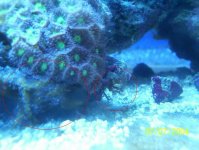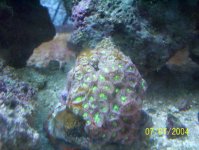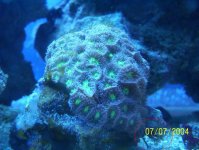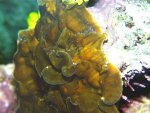I purchased this blastamussa merleti around 6-12 months ago.
The brown patch growing on the left side was on there when
I originally bought it but though nothing of it, assumed it was
some kind of sponge or something. There are also what lloks
like white fuzzy hairs on some parts of it. It has now grown
rather large compared to when I first added it to my tank and
now I'm getting worried not knowing exactly what it is and
wether it can/will damage my blastamussa.
Also there is another growth of somekind that I just recently
noticed on the right side and also have no idea what I'm dealing
with. Looks almost like a cluster of tube worms or possible one
of the dreaded anemones but I'm not sure of anything at this
point.
Lastly, I have some hair algae growing between the blastamussa's
and have tried turkey basting it and even a light scrubbing with a
tooth brush and still cant free it up. I don't wanna scrub to hard
because I don't wanna hurt my little buddies.
Can you awesome folks please help me out, kinda stressin out a
little You guys/gals rock!!
You guys/gals rock!!
The brown patch growing on the left side was on there when
I originally bought it but though nothing of it, assumed it was
some kind of sponge or something. There are also what lloks
like white fuzzy hairs on some parts of it. It has now grown
rather large compared to when I first added it to my tank and
now I'm getting worried not knowing exactly what it is and
wether it can/will damage my blastamussa.
Also there is another growth of somekind that I just recently
noticed on the right side and also have no idea what I'm dealing
with. Looks almost like a cluster of tube worms or possible one
of the dreaded anemones but I'm not sure of anything at this
point.
Lastly, I have some hair algae growing between the blastamussa's
and have tried turkey basting it and even a light scrubbing with a
tooth brush and still cant free it up. I don't wanna scrub to hard
because I don't wanna hurt my little buddies.
Can you awesome folks please help me out, kinda stressin out a
little









